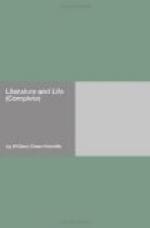I
That is to say, as I understand, that moods and tastes and fashions change; people fancy now this and now that; but what is unpretentious and what is true is always beautiful and good, and nothing else is so. This is not saying that fantastic and monstrous and artificial things do not please; everybody knows that they do please immensely for a time, and then, after the lapse of a much longer time, they have the charm of the rococo. Nothing is more curious than the charm that fashion has. Fashion in women’s dress, almost every fashion, is somehow delightful, else it would never have been the fashion; but if any one will look through a collection of old fashion plates, he must own that most fashions have been ugly. A few, which could be readily instanced, have been very pretty, and even beautiful, but it is doubtful if these have pleased the greatest number of people. The ugly delights as well as the beautiful, and not merely because the ugly in fashion is associated with the young loveliness of the women who wear the ugly fashions, and wins a grace from them, not because the vast majority of mankind are tasteless, but for some cause that is not perhaps ascertainable. It is quite as likely to return in the fashions of our clothes and houses and furniture, and poetry and fiction and painting, as the beautiful, and it may be from an instinctive or a reasoned sense of this that some of the extreme naturalists have refused to make the old discrimination against it, or to regard the ugly as any less worthy of celebration in art than the beautiful; some of them, in fact, seem to regard it as rather more worthy, if anything. Possibly there is no absolutely ugly, no absolutely beautiful; or possibly the ugly contains always an element of the beautiful better adapted to the general appreciation than the more perfectly beautiful. This is a somewhat discouraging conjecture, but I offer it for no more than it is worth; and I do not pin my faith to the saying of one whom I heard denying, the other day, that a thing of beauty was a joy forever. He contended that Keats’s line should have read, “Some things of beauty are sometimes joys forever,” and that any assertion beyond this was too hazardous.




